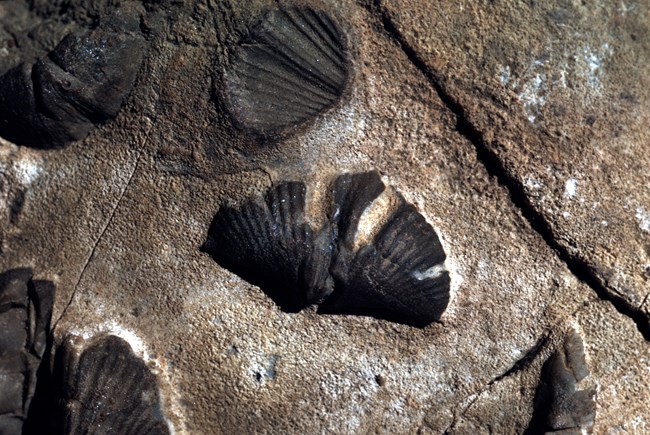
NPS Photo by John Tyers It’s old, complex, and filled with more boxwork than is found in all other caves on Earth put together. Any one of these qualities would make Wind Cave unique. Together they make it a world-class cave. And each component is essential to understanding how the cave formed. Laying the FoundationA warm shallow sea covered the area about 350 million years ago. Fragments of seashells, made of calcium carbonate, built up over time on the seafloor and eventually became limestone. Bodies of gypsum, made of calcium sulfate, also formed during this time when arid conditions caused seawater to evaporate and the minerals to crystallize. The gypsum formed irregular shaped masses within the limestone. The resulting rock is known as the Madison Limestone formation, or locally as the Pahasapa (Black Hills) Limestone. The gypsum masses were unstable. They grew and shrank as they absorbed and expelled water. This pressure fractured the gypsum and surrounding limestone. Like thick toothpaste, some gypsum squeezed into these cracks and crystallized in place. Later, water rich in carbonate ions converted all of the gypsum to calcite, or calcium carbonate. This set the stage for the cave and boxwork to form. The First Passages FormThe oceans receded allowing fresh water into the region. This naturally acidic freshwater reacted with the bodies of gypsum. They were converted to calcite, creating sulfuric or sulfurous acid as a byproduct. These acids dissolved the surrounding limestone to form the first cave passageways approximately 320 million years ago. Time, Time, TimeSeas continued to advance and retreat over the area for the next 240 million years. Sediment alternately deposited and eroded from atop the cave. The cave probably developed slowly until the most recent Black Hills uplift between 40 and 60 million years ago. The uplift opened more fractures in the limestone, allowing more cave to form. Water did not flow through the cave like a river. Instead, the water probably sat in the limestone for long periods of time, slowly enlarging small cracks into larger passageways, creating Wind Cave’s complex maze-like pattern. 
NPS Photo by Abby Rimstidt The Boxwork is RevealedSlow moving water also exposed the boxwork. By dissolving limestone at the edges of the former gypsum masses where expansion had formed cracks, the previously deposited crack fillings now stood in relief. These exposed crystal fins are called boxwork. The Cave DrainsGeologic studies suggest the water began slowly draining from the cave 40 to 50 million years ago. Today the water level is about 500 feet below the surface at an area named "the Lakes." Water, however, is still changing the cave. Slowly seeping water produces frostwork and cave popcorn on cave walls and ceilings. Flowstone or dripstone deposits, such as stalactites and stalagmites, are rare in Wind Cave due to the dry climate and semi-permeable overlying rock that limits water infiltration. 
NPS The Present CavePortions of Wind Cave are over 300 million years old, making it one of the oldest in the world. The cave is also large and extremely complex, with 167 miles of known cave (as of 2024) sitting under just 1.25 square miles of land. The boxwork is rare and found in few other caves. Geologists have many questions yet to answer before fully understanding the complex world below our feet. |
Last updated: August 18, 2024
